从零开始搭建一个K8S的环境
Posted 大象无形,大音希声
tags:
篇首语:本文由小常识网(cha138.com)小编为大家整理,主要介绍了从零开始搭建一个K8S的环境相关的知识,希望对你有一定的参考价值。
市面上有很多的K8S的书籍,但是关于如何搭建K8S的文章不多;下面笔者结合自己的经验,分享一下如何在阿里云的CentOs服务器上,搭建一个K8S的集群。
前提条件
一个阿里云的账号或者自己准备两台VM,其中一台是K8S的Master服务器,另外一台是K8S的Worker节点。
笔者自己在阿里云上面新建了2台按需付费的实例。

Master服务器:k8sMaster 172.24.137.71
Worker服务器:k8sWorker 172.24.137.72
因为Master节点和Worker节点要进行相互的网络访问,根据K8S对网络防火墙的要求,需要开通下面的端口
创建两个安全组:
Master节点加入下面的安全组
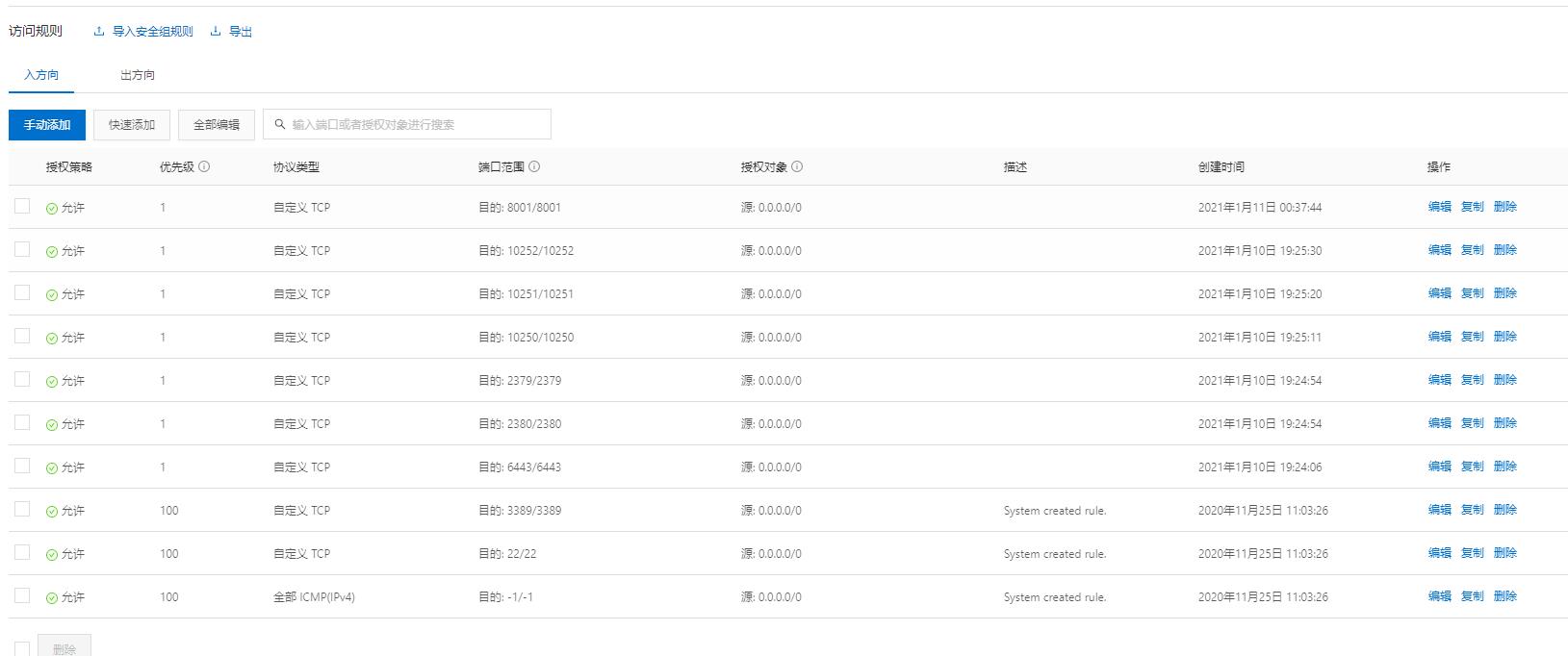
Woker节点加入下面的安全组

具体细节,请参考K8S防火墙
Master节点应该开的网络防火墙设置:

Worker节点应该开的网络防火墙设置:

1. 安装Docker
首先在Master服务器和Worker服务器上都要安装好Docker,为了加快安装的过程,需要把Docker安装文件的镜像指向国内的
阿里云镜像。如果直接用国外的,可能要1个多小时甚至更长时间下载安装包,但是如果直接指向http://mirrors.aliyun.com/docker-ce/linux/centos/docker-ce.rep,快的话,分分钟的时间就下载并安装完成。
1.1 更改源为阿里源
sudo yum remove docker \\
docker-client \\
docker-client-latest \\
docker-common \\
docker-latest \\
docker-latest-logrotate \\
docker-logrotate \\
docker-engine
sudo yum install -y yum-utils device-mapper-persistent-data lvm2
sudo yum-config-manager --add-repo http://mirrors.aliyun.com/docker-ce/linux/centos/docker-ce.rep
1.2 安装Docker
sudo yum install -y yum-utils device-mapper-persistent-data lvm2
sudo yum-config-manager --add-repo http://mirrors.aliyun.com/docker-ce/linux/centos/docker-ce.rep
yum list docker-ce --showduplicates | sort -r
sudo yum makecache fast
yum install docker-ce-18.06.3.ce-3.el7 docker-ce-cli-18.06.3.ce-3.el7 containerd.io
安装完后执行
systemctl enable docker
systemctl start docker
1.3 修改Docker的源为阿里自己的Docker Hub <可选>
安装完毕后, 建议将 docker 源替换为国内. 推荐阿里云镜像加速, 有阿里云账号即可免费使用.阿里云 -> 容器镜像服务 -> 镜像中心 -> 镜像加速
sudo mkdir -p /etc/docker
sudo tee /etc/docker/daemon.json <<-'EOF'
"registry-mirrors": ["https://xxxxx.mirror.aliyuncs.com"],
"exec-opts": ["native.cgroupdriver=systemd"],
"log-driver": "json-file",
"log-opts":
"max-size": "100m"
,
"storage-driver": "overlay2"
EOF
其中,xxxxx自己阿里云账号的Docker Hub Register中心
安装完后执行
sudo systemctl daemon-reload
sudo systemctl restart docker
2. 安装K8S
在Master和Worker的机器上都是一样的安装步骤
2.1 修改K8S的源为阿里的源
cat <<EOF > /etc/yum.repos.d/kubernetes.repo
[kubernetes]
name=Kubernetes
baseurl=http://mirrors.aliyun.com/kubernetes/yum/repos/kubernetes-el7-x86_64
enabled=1
gpgcheck=1
repo_gpgcheck=1
gpgkey=http://mirrors.aliyun.com/kubernetes/yum/doc/yum-key.gpg http://mirrors.aliyun.com/kubernetes/yum/doc/rpm-package-key.gpg
exclude=kube*
EOF
2.2 安装K8S的软件
yum install -y kubelet kubeadm kubectl --disableexcludes=kubernetes
systemctl enable kubelet && systemctl start kubelet
2.3 K8S的通用网络配置
cat <<EOF > /etc/sysctl.d/k8s.conf
net.bridge.bridge-nf-call-ip6tables = 1
net.bridge.bridge-nf-call-iptables = 1
EOF
sysctl --system
3. 配置Master节点和安装Dashboard
3.1 初始化Master节点
kubeadm config print init-defaults > kubeadm-init.yaml
修改模板文件的中2处配置:
将advertiseAddress: 1.2.3.4修改为本机地址
将imageRepository: k8s.gcr.io修改为imageRepository: registry.cn-hangzhou.aliyuncs.com/google_containers
[root@k8sMaster ~]# cat kubeadm-init.yaml
apiVersion: kubeadm.k8s.io/v1beta2
bootstrapTokens:
- groups:
- system:bootstrappers:kubeadm:default-node-token
token: abcdef.0123456789abcdef
ttl: 24h0m0s
usages:
- signing
- authentication
kind: InitConfiguration
localAPIEndpoint:
advertiseAddress: 172.24.137.71
bindPort: 6443
nodeRegistration:
criSocket: /var/run/dockershim.sock
name: k8smaster
taints:
- effect: NoSchedule
key: node-role.kubernetes.io/master
---
apiServer:
timeoutForControlPlane: 4m0s
apiVersion: kubeadm.k8s.io/v1beta2
certificatesDir: /etc/kubernetes/pki
clusterName: kubernetes
controllerManager:
dns:
type: CoreDNS
etcd:
local:
dataDir: /var/lib/etcd
imageRepository: registry.cn-hangzhou.aliyuncs.com/google_containers
kind: ClusterConfiguration
kubernetesVersion: v1.20.0
networking:
dnsDomain: cluster.local
serviceSubnet: 10.96.0.0/12
scheduler:
3.2 下载K8S Master节点的依赖的管理Docker镜像
kubeadm config images pull --config kubeadm-init.yaml
3.3 执行初始化
kubeadm init --config kubeadm-init.yaml
最后两行需要保存下来, kubeadm join …是 worker 节点加入所需要执行的命令.
其参考格式如下:
kubeadm join 172.24.137.71:6443 --token 6s1u3g.rns2x03czqjux1x1 \\
--discovery-token-ca-cert-hash sha256:da3ffd7e60b1ad55f2a95ea6375f15deb21d09299eb0b803b9f7fb8a4ad0a356
3.4 配置kubectl命令
为了能够使用kubectl, 需要依赖/etc/kubernetes/admin.conf 文件,配置方法
在当前的登陆用户名下,新建一个.kube的目录,kubectl默认会读取这个文件夹下的配置,然后执行下面的复制命令
sudo cp -i /etc/kubernetes/admin.conf $HOME/.kube/config
此时,就能执行kubectl的相关命令
[root@k8sMaster ~]# kubectl
kubectl controls the Kubernetes cluster manager.
Find more information at:
https://kubernetes.io/docs/reference/kubectl/overview/
Basic Commands (Beginner):
create Create a resource from a file or from stdin.
expose Take a replication controller, service, deployment or pod and
expose it as a new Kubernetes Service
run Run a particular image on the cluster
set Set specific features on objects
Basic Commands (Intermediate):
explain Documentation of resources
get Display one or many resources
edit Edit a resource on the server
delete Delete resources by filenames, stdin, resources and names, or by
resources and label selector
Deploy Commands:
rollout Manage the rollout of a resource
scale Set a new size for a Deployment, ReplicaSet or Replication
Controller
autoscale Auto-scale a Deployment, ReplicaSet, or ReplicationController
Cluster Management Commands:
certificate Modify certificate resources.
cluster-info Display cluster info
top Display Resource (CPU/Memory/Storage) usage.
cordon Mark node as unschedulable
uncordon Mark node as schedulable
drain Drain node in preparation for maintenance
taint Update the taints on one or more nodes
Troubleshooting and Debugging Commands:
describe Show details of a specific resource or group of resources
logs Print the logs for a container in a pod
attach Attach to a running container
exec Execute a command in a container
port-forward Forward one or more local ports to a pod
proxy Run a proxy to the Kubernetes API server
cp Copy files and directories to and from containers.
auth Inspect authorization
debug Create debugging sessions for troubleshooting workloads and
nodes
Advanced Commands:
diff Diff live version against would-be applied version
apply Apply a configuration to a resource by filename or stdin
patch Update field(s) of a resource
replace Replace a resource by filename or stdin
wait Experimental: Wait for a specific condition on one or many
resources.
kustomize Build a kustomization target from a directory or a remote url.
Settings Commands:
label Update the labels on a resource
annotate Update the annotations on a resource
completion Output shell completion code for the specified shell (bash or
zsh)
Other Commands:
api-resources Print the supported API resources on the server
api-versions Print the supported API versions on the server, in the form of
"group/version"
config Modify kubeconfig files
plugin Provides utilities for interacting with plugins.
version Print the client and server version information
Usage:
kubectl [flags] [options]
Use "kubectl <command> --help" for more information about a given command.
Use "kubectl options" for a list of global command-line options (applies to all
commands).
3.5 配置Master节点的网络
wget https://docs.projectcalico.org/v3.8/manifests/calico.yaml
kubectl apply -f calico.yaml
3.6 安装Dashboard
3.6.1 安装Dashboard
安装Dashboard的命令行如下:
wget https://raw.githubusercontent.com/kubernetes/dashboard/v2.0.0-beta4/aio/deploy/recommended.yaml
kubectl apply -f recommended.yaml
kubectl get pods --all-namespaces | grep dashboard
kubernetes-dashboard dashboard-metrics-scraper-7445d59dfd-pvr5q 1/1 Running 3 6d23h
kubernetes-dashboard kubernetes-dashboard-5d6fdccd5-l5bk7 1/1 Running 3 6d23h
3.6.2 创建Dashboard用户
创建一个用于登录 Dashboard 的用户. 创建文件dashboard-adminuser.yaml内容如下:
apiVersion: v1
kind: ServiceAccount
metadata:
name: admin-user
namespace: kube-system
---
apiVersion: rbac.authorization.k8s.io/v1
kind: ClusterRoleBinding
metadata:
name: admin-user
roleRef:
apiGroup: rbac.authorization.k8s.io
kind: ClusterRole
name: cluster-admin
subjects:
- kind: ServiceAccount
name: admin-user
namespace: kube-system
并执行下面的命令
kubectl apply -f dashboard-adminuser.yaml
3.6.3 生成Dashboard证书
grep 'client-certificate-data' ~/.kube/config | head -n 1 | awk 'print $2' | base64 -d >> kubecfg.crt
grep 'client-key-data' ~/.kube/config | head -n 1 | awk 'print $2' | base64 -d >> kubecfg.key
openssl pkcs12 -export -clcerts -inkey kubecfg.key -in kubecfg.crt -out kubecfg.p12 -name "kubernetes-client"
3.6.4 登陆Dashboard
打开 Dashboard的时候,会首先进入下面的认证的页面。
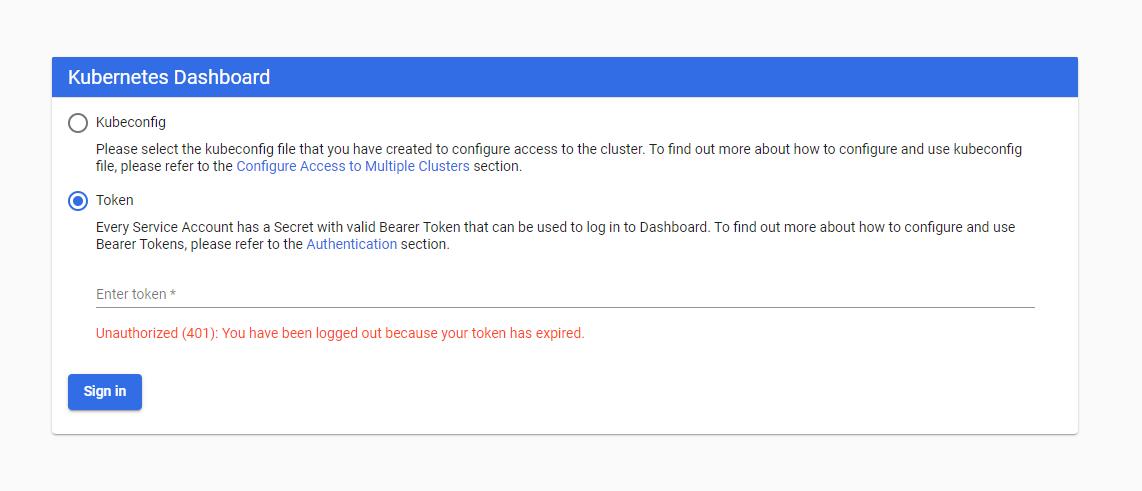
一般我们会使用第二种方式,就是获取到Token,其命令如下
kubectl -n kube-system describe secret $(kubectl -n kube-system get secret | grep admin-user | awk 'print $1')
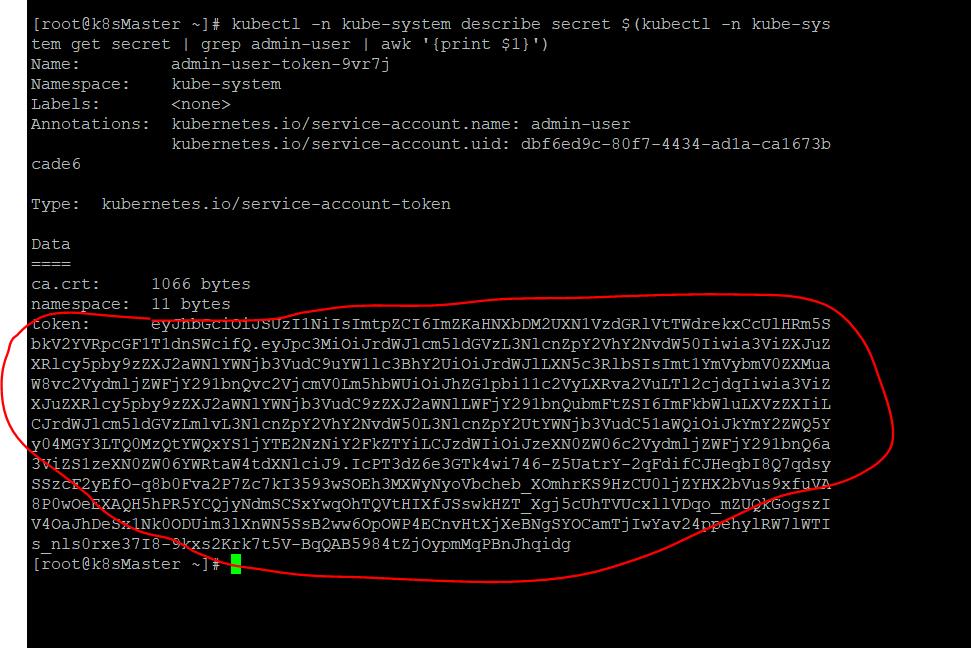
拷贝上面Token的值,注意不要包括前面的空格
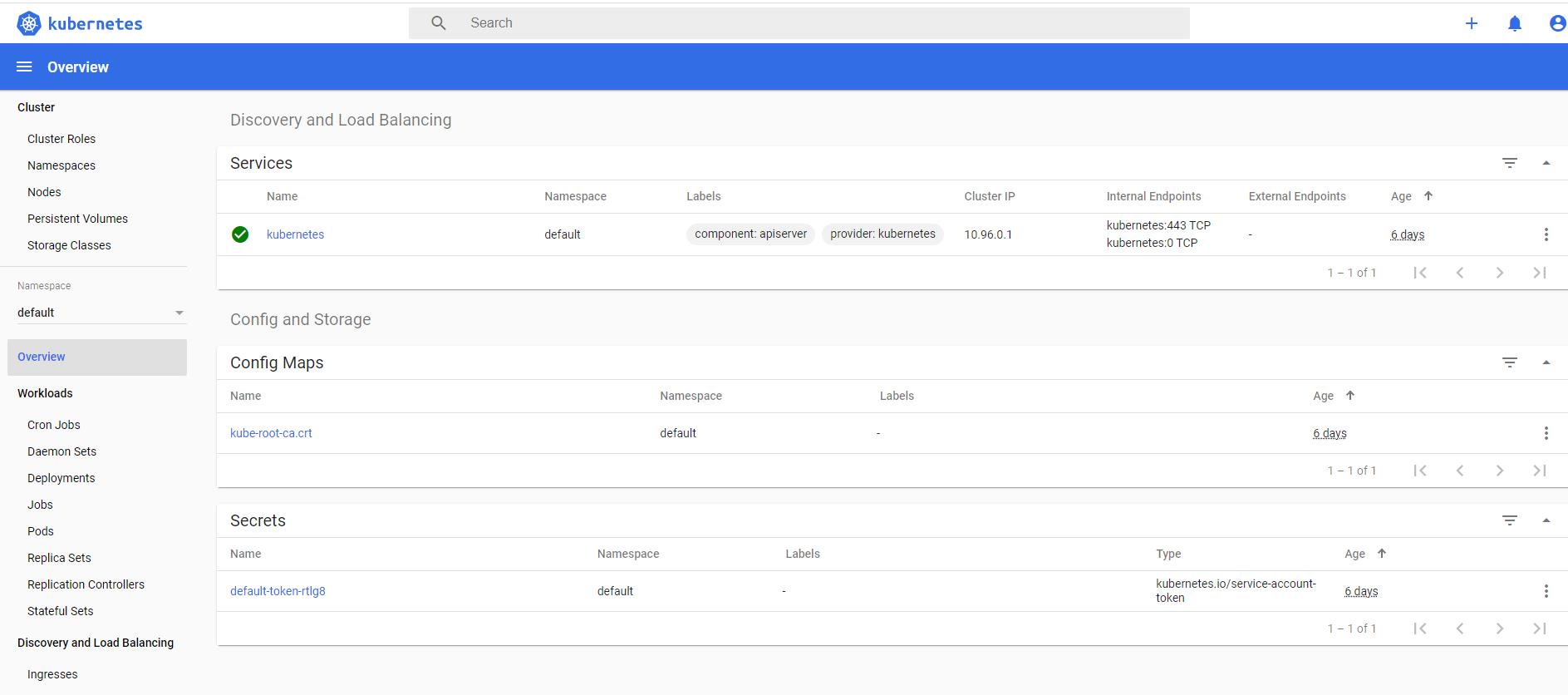
至此,所有的Docker的列表如下:

4. 配置Worker节点并加入Master节点
Worker节点的加入比较简单,直接执行上面提到的 “kubeadm join ” 命令
kubeadm join 172.24.137.71:6443 --token 6s1u3g.rns2x03czqjux1x1 \\
--discovery-token-ca-cert-hash sha256:da3ffd7e60b1ad55f2a95ea6375f15deb21d09299eb0b803b9f7fb8a4ad0a356
5. 常见问题
5.1 Worker节点执行kubectl失败
k8s集群slave节点使用kubectl命令时The connection to the server localhost:8080 was refused - did you specify the right host or port?
mkdir -p /root/.kube
scp root@172.24.137.71:/root/.kube/* /root/.kube 或者 cp -i /etc/kubernetes/admin.kubeconfig /root/.kube/config
kubectl get nodes
5.2 Dashboard在公网环境下不能访问登陆页面
Dashboard在公网环境下不能打开下面的访问登陆页面,
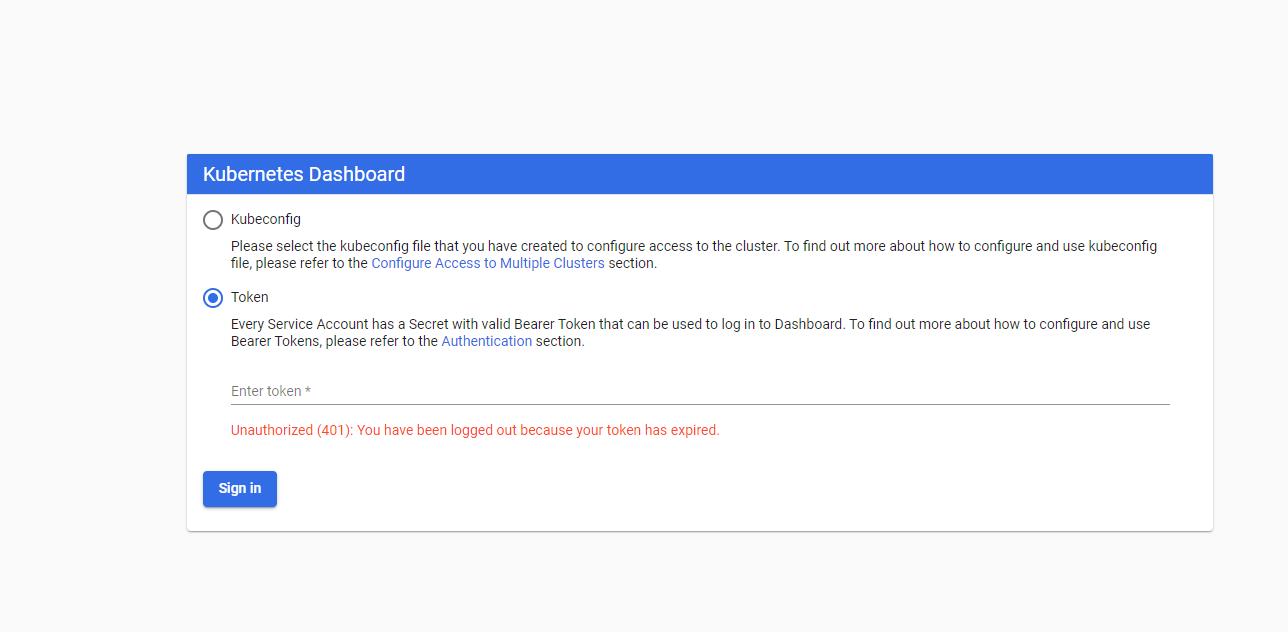
解决方案:
在Master节点执行下面的命令
kubectl create clusterrolebinding test:anonymous --clusterrole=cluster-admin --user=system:anonymous
5.3 在Join Master节点的时候,一直在“pre flight”命令行下不动
Worker节点在加入Master节点时,一直在“pre flight”命令行下不动
kubeadm join 172.24.137.71:6443 --token 6s1u3g.rns2x03czqjux1x1 \\
--discovery-token-ca-cert-hash sha256:da3ffd7e60b1ad55f2a95ea6375f15deb21d09299eb0b803b9f7fb8a4ad0a356
解决办法: 原因是Master生成的Token过期了
登陆到Master服务器上
3.1 原因是第一次生成的Token 过期了
kubeadm token list //token列表 ,第一次登陆上去,应该列表是空的
kubeadm token create --ttl 0 //永不失效
kubeadm token create //有效期一天
3.2 看出CA Token,一般CA Token是不会过期的
openssl x509 -pubkey -in /etc/kubernetes/pki/ca.crt | openssl rsa -pubin -outform der 2>/dev/null | openssl dgst -sha256 -hex | sed 's/^.* //'
46f6cf1d84d0eadb4f6e7f05b908e5572025886d9f134db27f92b98e1c3dd3ed //token
3.3 重新生成新的Worker加入Master节点的命令
kubeadm join 172.24.137.71:6443 --token abcdef.0123456789abcdef \\
--discovery-token-ca-cert-hash sha256:da3ffd7e60b1ad55f2a95ea6375f15deb21d09299eb0b803b9f7fb8a4ad0a356
参考文档
kubernetes join 卡住 token过期
Kubernetes(一) 跟着官方文档从零搭建K8S
以上是关于从零开始搭建一个K8S的环境的主要内容,如果未能解决你的问题,请参考以下文章